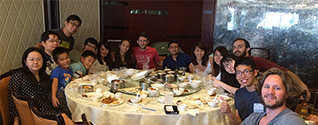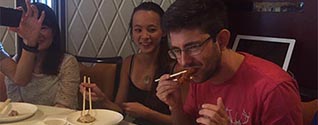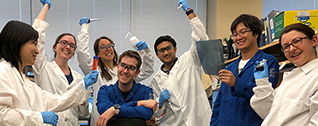Bisulfite genomic sequencing protocol (8/99)
DAY 1
1) Digest 2ug of genomic DNA with enzymes that cut just outside of the region of interest, total volume of 100ul, about 10 units of each enzyme. Use small epindorf tubes. Digestion should be complete; sometimes we use a number of enzymes so the DNA is cut by at least two enzymes on each side. For standard SUP assay, use EcoR1 and Fok1 in EcoR1 buffer. Remember to take extreme precaution against contamination from old PCR products throughout entire procedure. Bleach pipets, etc.
2) Add 1.5 ul 20ug/ul tRNA or glycogen, phenol/chloroform extract, transfer 90ul of aqueous phase to a fresh 0.5ml tube. Precipitate with 38.6 ul 10M NH4OAC and 385 ul EtOH. Spin 15 minutes, 70% EtOH wash very carefully and remove all liquid. Repeat this wash again. Dry pellet completely.
3) Resuspend in 40ul water. (Start step 5 now) Heat at 97C 5 min. in PCR machine. Quench in ice/water 1 min.
4) Add 2ul of 6.3M NaOH (5.04g/20mls, freshly prepared and relatively new NaOH). Incubate 39C for 30 min.
5) Dissolve 40.5g of sodium bisulfite (Fisher S654-500) in 80mls of water with slow stirring to avoid aeration. Adjust pH to 5.1 with 10M NaOH (takes about 2mls)(8g/ 20mls, freshly prepared). Add 3.3mls of 20mM hydroquinone (1.1g/ 500mls water; Sigma H-9003). Adjust volume to 100mls.
** Note, because it takes >10min for the sodium bisulfite to dissolve, this step should be started at the same time as step 3 is started.
6) Add 416ul of the bisulfite solution to the denatured DNA. Do this in the PCR machine, so that the denatured DNA is still at 39C. Mix. Overlay with mineral oil. Incubate in PCR machine at 55C for 16 hours in the dark, with a jolt to 95C for 5 min every three hours.
DAY 2
7) Serially transfer solution through two 1.5ml tubes to remove all of the mineral oil.
8) Desalt samples with the Wizard DNA Clean-up System, Promega Cat# A7280. Follow Manufacturer's protocol exactly.
9) Measure the exact volume of TE recovered from the column, and add 6.3M NaOH (from day 1) to a final concentration of 0.3M, incubate at 37C for 15 min.
10) Add 10M NH4OAC pH 7.0 to a final concentration of 3M, add 2ul of 20ug/ul tRNA or glycogen, and 3 volumes EtOH. Spin 15 min, 70% wash and dry pellet. Resuspend in 100ul of TE. Use 2ul for each PCR reaction.
Note: The most critical aspect of the protocol is complete denaturation of the genomic DNA so that the bisulphite conversion is complete. This means that the enzyme digestion should be complete, and the denaturation steps done carefully. Make sure there is no salt in the DNA for the 96C denaturation step.
PCR
Primer design is critical. Length should be about 30 nt. We use T at the 3' base, which corresponds to a converted C in the genomic sequence. This way only BS converted DNA can be amplified. The size of the PCR product should be under about 800bp. Often we have to do a nested PCR using 4 primers. We use 40 cycles with the first set of primers using 3.0mM Mg and a 50C annealing temp. Typically we use 94C, 20 sec; 50C, 30sec; 72C, 1min. Then for the nested PCR (if needed), take 0.1 ul of the first PCR and do 30 more cycles in a new reaction with the two nested primers. For primer design, try to find regions which are relatively rich in G's or C's (i.e. for the top strand amplification there are no C's in the primer on the 5' side and no Gs in the primer on the 3' side). In my hands the best primers contain 6 to 8 C's or G's.
SEQUENCING
The easiest procedure is to sequence the PCR product directly with the ABI fluorescent sequencing. For this, I purify the PCR product with the Quiagen PCR quick spin columns, and elute in 30ul of water. For an 800bp PCR product, one should use about 50ng of product (as estimated on an agarose gel) per sequencing reaction. Sometimes the primers used for PCR don't work that great as sequencing primers, especially when there are non-specific bands or primer-dimers present in the sample. I sometimes make new primers for sequencing, using the same criteria as outlined above. This way the sequencing works fine even if the PCR is not so clean.
An alternative procedure is to clone the PCR products and sequence a number of individual clones.







